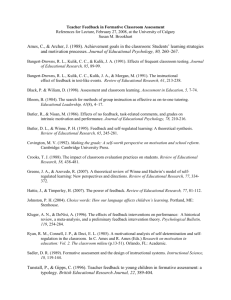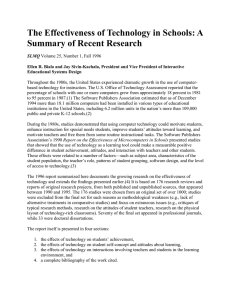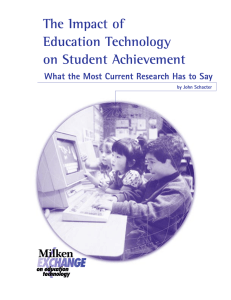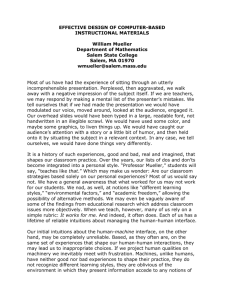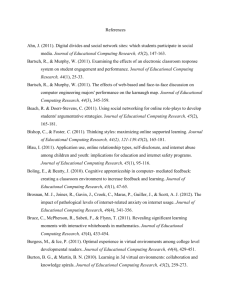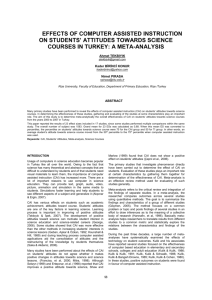ERIC Identifier: ED315063
advertisement
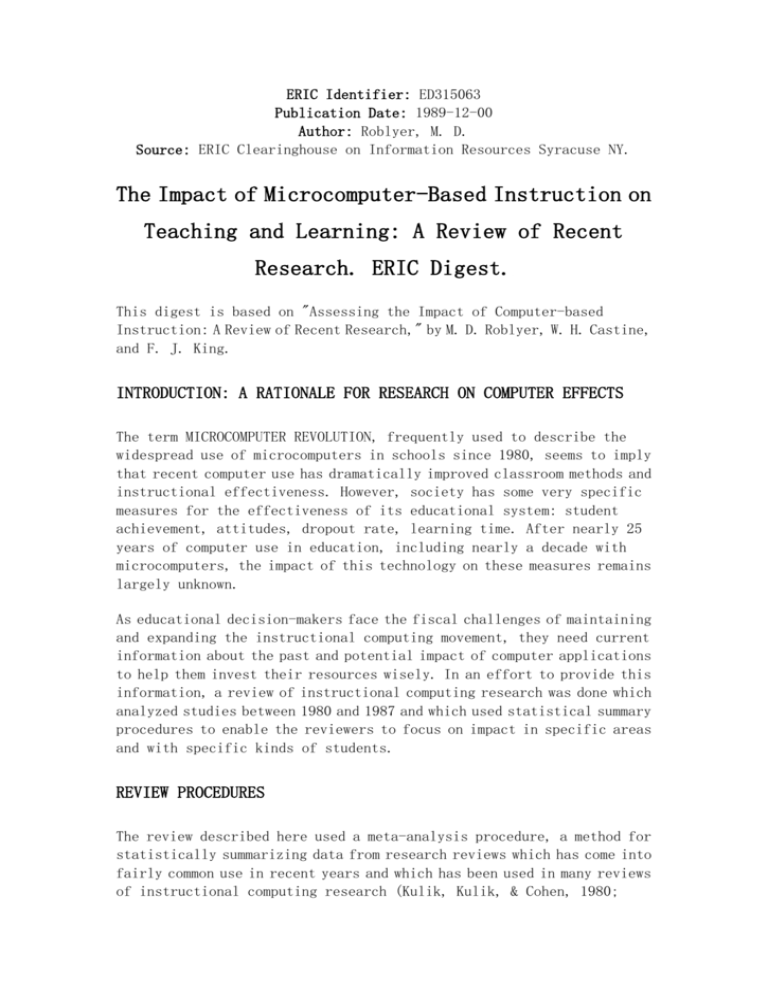
ERIC Identifier: ED315063 Publication Date: 1989-12-00 Author: Roblyer, M. D. Source: ERIC Clearinghouse on Information Resources Syracuse NY. The Impact of Microcomputer-Based Instruction on Teaching and Learning: A Review of Recent Research. ERIC Digest. This digest is based on "Assessing the Impact of Computer-based Instruction: A Review of Recent Research," by M. D. Roblyer, W. H. Castine, and F. J. King. INTRODUCTION: A RATIONALE FOR RESEARCH ON COMPUTER EFFECTS The term MICROCOMPUTER REVOLUTION, frequently used to describe the widespread use of microcomputers in schools since 1980, seems to imply that recent computer use has dramatically improved classroom methods and instructional effectiveness. However, society has some very specific measures for the effectiveness of its educational system: student achievement, attitudes, dropout rate, learning time. After nearly 25 years of computer use in education, including nearly a decade with microcomputers, the impact of this technology on these measures remains largely unknown. As educational decision-makers face the fiscal challenges of maintaining and expanding the instructional computing movement, they need current information about the past and potential impact of computer applications to help them invest their resources wisely. In an effort to provide this information, a review of instructional computing research was done which analyzed studies between 1980 and 1987 and which used statistical summary procedures to enable the reviewers to focus on impact in specific areas and with specific kinds of students. REVIEW PROCEDURES The review described here used a meta-analysis procedure, a method for statistically summarizing data from research reviews which has come into fairly common use in recent years and which has been used in many reviews of instructional computing research (Kulik, Kulik, & Cohen, 1980; Bangert-Drowns, Kulik, & Kulik, 1985; Kulik, Kulik, & Bangert-Drowns, 1985). Meta-analysis calls for calculating a measure of impact (an "effect size") for each study included in the review. This measure is then summarized across studies, and the relationship of effects with various factors (e.g., impact at various grade levels and content areas) is calculated. Methods used in the current review, however, used recently-developed means of calculating and comparing effect sizes which made meta-analysis results more meaningful than those of past reviews of instructional computing research. Studies were located through traditional means: online searches of ERIC and DISSERTATION ABSTRACTS, manual searches of more recent journal issues, bibliographies from past reviews, and contacts with experts in the field for unpublished reports. Of the over 200 complete studies located, 38 published and unpublished studies and 44 dissertations met the criteria necessary to include them in the meta-analysis. Effect sizes were calculated for each study, and these effects were summarized across studies and compared in a number areas. TRENDS IN STUDY RESULTS An overall finding was that computer applications had a statistically significant positive effect (p<.05) in a majority of the areas examined. However, there was a wide variation in the focuses, procedures, materials, and findings among the studies included in the meta-analysis, as well as a paucity of acceptable studies in many categories. Therefore, the results given here must be interpreted cautiously until more studies of similar types and with similar reporting styles are available to confirm or deny these trends. The following sections provide tentative answers to some questions being asked about the effectiveness of computer-based instruction. ARE COMPUTER APPLICATIONS MORE EFFECTIVE AT CERTAIN GRADE LEVELS? Significant effects were found at all levels. This review found larger effects at college and adult levels than at elementary and secondary levels. ARE COMPUTER APPLICATIONS MORE EFFECTIVE WITH CERTAIN TYPES OF CONTENT? Computer applications seemed to have slightly greater effects with mathematics than with reading/language skills, but this difference was not statistically significant. Using computers to teach cognitive skills (problem solving and critical thinking) had an overall effect about equal to that for mathematics and for reading/language. One of the highest effects observed in the entire review was that for science, but the number of acceptable studies was especially small. ARE COMPUTER APPLICATIONS MORE EFFECTIVE WITH CERTAIN KINDS OF STUDENTS? This study found no statistically significant evidence of a relationship between student ability level and the effectiveness of computer-based applications. Neither was there firm evidence that effectiveness is linked to a student's gender. The issue of differential effects for these populations bears further study. DO STUDENT ATTITUDES IMPROVE AS A RESULT OF USING COMPUTERS? Student attitudes toward school and subject matter was the most studied variable and seemed the most affected by computer use. Improving students' self-image and self-esteem, while much talked about in the literature, was not much studied, but the trend in the data was positive. Only a few studies were located which compared attitudes toward computer instructional methods with non-computer ones, and the data seemed to indicate that there was no difference in student attitudes. WHAT IS THE COMPARATIVE EFFECTIVENESS OF VARIOUS APPLICATION TYPES (DRILL, TUTORIAL, AND OTHER)? Only applications in mathematics and reading/language skills were analyzed, since these were the only content areas with enough studies to support comparison. While effects seemed slightly higher for tutorials in reading, statistical results allow no firm conclusions about the superiority of any type of application. Trends in the data do indicate the need for further study of whether or not drill applications are better for lower- level skills (e.g., word analysis) and tutorials for higher-level skills (e.g., comprehension). HOW EFFECTIVE ARE COMPUTER APPLICATIONS IN TEACHING ENGLISH AND READING TO ESL STUDENTS? Effectiveness was low overall and was even found to be negative in studies involving Hispanic students. Because there were very few studies in this area, however, results must be viewed with caution. HOW EFFECTIVE IS WORD PROCESSING IN IMPROVING WRITING SKILLS? Word processing seems to have a positive effect on student attitudes toward writing. No firm conclusions can be drawn, however, about the effect of word processing on writing quality, length of composition, and number and kind of revisions. HOW EFFECTIVE ARE LOGO AND CAI APPLICATIONS TO TEACH PROBLEM-SOLVING SKILLS? The effects of Logo applications on problem-solving and general thinking skills were found to be significant. Effects achieved with so-called problem-solving CAI were not different from zero. On the basis of these findings, Logo shows promise as a method of enhancing cognitive skills of various kinds, and it looks especially good in comparison with unstructured, discovery- learning CAI applications. CAN COMPUTER APPLICATIONS INCREASE STUDENT CREATIVITY? All usable studies in this area were Logo-based and showed an overall effect higher than any other found in this review. These results, while promising, are in need of further study, preferably with larger sample sizes and control groups which use other forms of instructional treatment. IMPLICATIONS OF FINDINGS FOR FUTURE USE IN THE FIELD This review indicates, not surprisingly, that computer-based instruction is potentially effective in most educational applications. However, computer-using educators should keep the following in mind when choosing applications: * Since significant results have been found at all grade levels, current data cannot be used either to increase or decrease use of computer applications at any particular grade level. * Computer uses in all content areas except ESL seem productive, and science may be an especially promising area. However, the type of application and the use to which it is put seem to dictate how great the impact will be. * While using computer applications does seem to significantly improve student attitudes toward school and subject matter, administrators and teachers should not expect to justify computer purchases with these kinds of findings. To date, insufficient data exist to indicate that better attitudes have any impact on achievement or on drop-out rate. * Most types of skill can profit from computer applications, but word processing and uses of Logo to enhance creativity and problem-solving skills are especially promising. * Until further studies explain the negative effects found in this review, special caution should be used when contemplating computer methods to teach English language skills to Hispanic students. CONCLUSION The single greatest problem facing a systematic assessment of the impact of the microcomputer revolution on teaching and learning is the lack of sufficient numbers of studies in key areas. Findings indicate that computer applications have an important role to play in the future of education, but the exact nature of that role has only begun to be explored. Opportunities for using technology to make an impact on education have never been greater, and neither have opportunities for research. The next decade must be a time for taking full advantage of both. REFERENCES Bangert-Drowns, R. L., Kulik, J. A., & Kulik, C. C. (1985). Effectiveness of computer-based education in secondary schools. JOURNAL OF COMPUTER-BASED INSTRUCTION, 12, 59-68. Kulik, J. A., Kulik, C. C., & Bangert-Drowns, R. L. (1985). Effectiveness of computer-based education in elementary schools. COMPUTERS IN HUMAN BEHAVIOR, 1, 59-74. Kulik, J. A., Kulik, C. C., & Cohen, P. A. (1980). Effectiveness of computer-based teaching: A meta-analysis of findings. REVIEW OF EDUCATIONAL RESEARCH, 50(4), 525-544. Roblyer, M. D., Castine, W. H., & King, F. J. (1988). Assessing the Impact of Computer-Based Instruction: A Review of Recent Research. Binghamton, NY: Haworth. This digest, based on Assessing the Impact of Computer-Based Instruction: A Review of Recent Research by M. D. Roblyer, W. H. Castine, and F. J. King, was prepared for the ERIC Clearinghouse on Information Resources by M. D. Roblyer.
